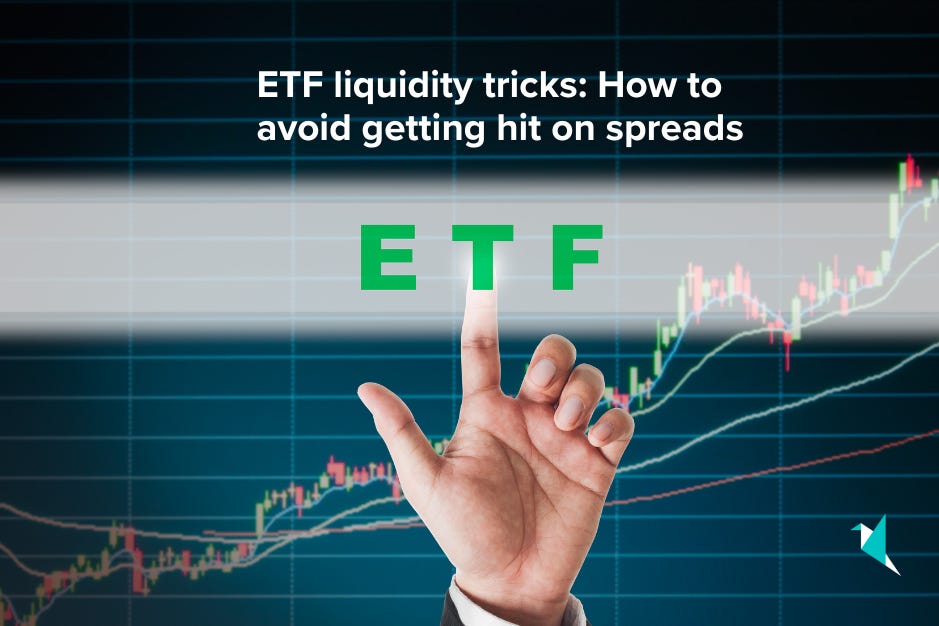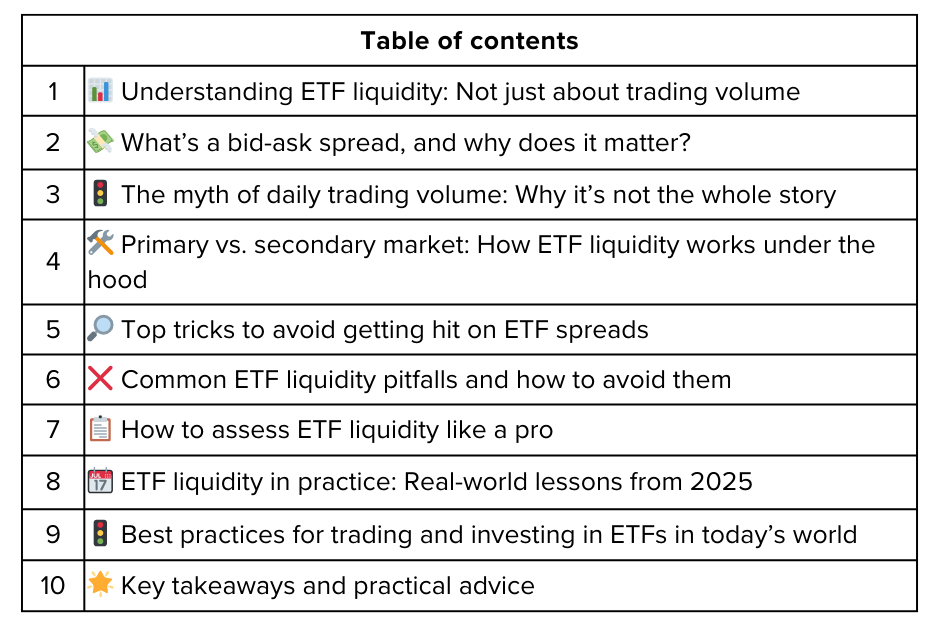ETF liquidity tricks: How to avoid getting hit on spreads
Exchange-traded funds (ETFs) have become a cornerstone of modern investing, offering fast trading, diversification, and transparency all in one tidy package. But many investors don’t realize that buying and selling an ETF isn’t always as effortless as it seems—especially when it comes to liquidity and trading costs. One of the sneakiest drains on returns comes from bid-ask spreads, which can quietly eat into your profits with each purchase or sale. This guide will break down the real story about ETF liquidity, how to sniff out spread dangers, and the smartest ways to trade ETFs in today’s fast-moving markets.
🔔 Don’t miss out!
Add winvestacrisps@substack.com to your email list so our updates never land in spam
Understanding ETF liquidity: Not just about trading volume 📊
ETF liquidity is more complex than just how many shares trade each day. With stocks, liquidity is obvious: higher daily trading volume usually means easier, cheaper trades. But ETFs have two distinct layers of liquidity:
Secondary market liquidity – how often and easily ETF units are traded on an exchange (just like a stock).
Primary market liquidity – the ability of market makers and authorized participants to create or redeem ETF shares by purchasing (or selling) the underlying basket of securities.
Key point: Even ETFs with low trading volume can still be highly liquid if the underlying assets are easy to trade. Conversely, an ETF might trade constantly but still have wide spreads if the underlying holdings are illiquid.
What’s a bid-ask spread, and why does it matter? 💸
The bid-ask spread is the gap between the highest price buyers are willing to pay (the bid) and the lowest price sellers will accept (the ask).
Narrow spreads: Indicate high liquidity. Easy to trade, lower hidden cost.
Wide spreads: Signal low liquidity. You’ll pay more to buy, receive less when you sell, or both.
For large or frequently-traded ETFs (like SPY or QQQ), spreads are often just a penny or two. For less popular, volatile, or sector-specific ETFs, spreads can be much wider—sometimes costing you multiple percentage points per trade.
The myth of daily trading volume: Why it’s not the whole story 🚦
Many investors mistakenly judge an ETF’s liquidity based solely on trading volume. In reality, ETF liquidity depends far more on the liquidity of the underlying assets within the ETF’s portfolio.
Examples:
An ultra-short bond ETF with just a few thousand units trading daily can still move millions if the underlying bonds are highly liquid.
A small-cap or emerging market ETF might trade briskly, but if the stocks inside are thinly traded, spreads can still jump unexpectedly.
Watch out for:
ETFs with fancy strategies or niche sectors, as these are often thinly traded.
International or thematic ETFs tracking assets in countries or sectors with limited trading.
Primary vs. secondary market: How ETF liquidity works under the hood 🛠️
Secondary market: Most retail trades happen here, between buyers and sellers on the exchange, directly affecting quoted prices and spreads.
Primary market: When there’s a big imbalance, authorized participants (APs) can create or redeem ETF units by delivering or taking the actual securities in the ETF’s portfolio. This mechanism helps keep ETF prices in line with net asset value (NAV).
What this means: If you want to make an unusually large purchase or sale, ETF liquidity ultimately expands to match the depth of the underlying assets, not just the number of ETF units trading hands.
Top tricks to avoid getting hit on ETF spreads 🔎
1. Always use limit orders, never a “market” order by default
Market orders tell your broker to buy or sell instantly at the best available price, which could be far worse than what you expect if the spread is wide or liquidity thin.
Limit orders let you set the specific price at which you’ll buy or sell, protecting you from accidental overpaying or underselling.
Set your limit price near the mid-point between bid and ask, especially on less liquid ETFs.
2. Check the underlying liquidity, not just ETF trading volume
Look up the ETF’s underlying holdings using a fact sheet or screener.
Analyze liquidity at the asset class level: are the underlying stocks or bonds heavily traded? Are they in remote markets or illiquid sectors?
The tighter the underlying spreads, the tighter your ETF spreads should be.
3. Trade during peak market hours, avoid the open and close
Liquidity is best in the middle of the trading day (about 10:30 AM to 3:00 PM in the U.S.).
Opening and closing minutes often see wider spreads due to uncertainty and lower market maker activity.
If you must trade large volumes, break your order up into smaller parts.
4. Compare similar ETFs for spreads
Some ETFs tracking the same index are much more liquid than others.
Use online tools to compare the bid-ask spread and daily trading volume for several funds in your target area.
Favor ETFs with higher liquidity and narrower spreads when everything else is equal.
5. Watch premium and discount to NAV
ETFs can sometimes trade slightly above (“premium”) or below (“discount”) their NAV, especially when underlying assets are hard to price or markets are volatile.
Use ETF providers’ tools to check historical premiums/discounts.
Common ETF liquidity pitfalls and how to avoid them ❌
Pitfall 1: Trading illiquid ETFs in giant blocks
Large orders in thin ETFs can move the market against you, costing you more in hidden slippage than you expect. For significant trades, work with your broker’s trading desk or the ETF’s capital markets desk to source liquidity across both layers.
Pitfall 2: Assuming “cheap” trading is always available
RETIREMENT INVESTORS: Just because an ETF has low fees doesn’t mean trading it will always be cheap. Wide spreads can quickly eat up years’ worth of cost advantage, especially if you trade often.
Pitfall 3: Focusing only on U.S. trading hours
If your ETF tracks international assets, be mindful that optimal trading times may not line up with U.S. market hours. This can cause wider spreads or price gaps outside the relevant market’s timezone.
Pitfall 4: Ignoring expense ratios, commissions, and all-in costs
Always add up the bid-ask spread, trading commissions, and expense ratio to understand your total trading and holding cost.
How to assess ETF liquidity like a pro 📋
Check the average bid-ask spread: Use free market data to view what buyers and sellers are posting in real time.
Examine the ETF’s average daily trading volume: The higher, the better, but not the only factor.
Look up the underlying asset liquidity: Liquid underlying assets make for a nimbler ETF, even if the ETF itself is new or lightly traded.
Investigate recent premium/discount patterns: Frequent and large discounts are a warning sign.
Monitor times of day for best execution: Record several trades at different times to learn when spreads are tightest.
ETF liquidity in practice: Real-world scenarios and lessons from 2025 📆
ETF boom and niche launches
As thematic and sector ETFs continue to explode in number—AI, green energy, emerging markets, and more—spread awareness has become even more important. Many flashy new products feature sexy tickers but low liquidity, leaving investors open to getting hit with wide spreads.
Market volatility and liquidity crunches
When volatility spikes, even normally liquid ETFs can see spreads widen dramatically. Sudden news, central bank policy changes, and geopolitical shocks can all limit market maker willingness to post tight prices.
Why institutional investors rarely get clipped by spreads
Institutional traders usually:
Break up large trades into smaller chunks.
Pre-arrange block trades or work with ETF capital markets desks.
Use algorithms to seek out best prices.
Individual investors can learn from these tactics—slow and steady trading wins the race.
Best practices for trading and investing in ETFs in today’s world 🚦
Avoid trading ETFs when the underlying markets are closed or volatile.
Opt for limit orders and stay patient for tight pricing.
Don’t be lured by the newest or smallest ETFs unless you understand the liquidity risks.
Consider the full cost of owning and trading an ETF, including expense ratio, spreads, and any platform charges.
Stay informed—review fact sheets, SEC filings, and liquidity statistics regularly.
Key takeaways and practical advice 🌟
ETF liquidity is a two-layered system—secondary trading activity and the liquidity of the underlying basket.
Bid-ask spreads are the “silent fee” of ETF trading; tight spreads save money, wide ones erode returns.
Protect yourself by using limit orders, trading at the right times, examining the underlying assets, and staying vigilant about premium/discount.
Never assume an ETF is truly “cheap” just because it’s popular or has a low expense ratio, look under the hood.
Market shifts in 2025 have only made liquidity awareness more critical for all ETF investors.
By following these ETF liquidity tricks, you’ll avoid getting hit by unnecessary trading costs and put yourself in the best position to grow your wealth, trade smarter, and sleep easy in any market.
Poll 📊
🚀 Join 60,000+ investors—become a paying subscriber or download the Winvesta app and fund your account to get insights like this for free!
Disclaimer: This article is for informational purposes only and does not constitute investment advice. Always conduct your own research and consider seeking professional financial advice before making any investment decisions.







